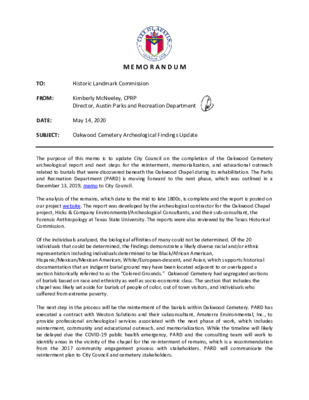Oakwood Cemetery memo — original pdf
Backup

M E M O R A N D U M TO: FROM: Historic Landmark Commission Kimberly McNeeley, CPRP Director, Austin Parks and Recreation Department May 14, 2020 Oakwood Cemetery Archeological Findings Update DATE: SUBJECT: The purpose of this memo is to update City Council on the completion of the Oakwood Cemetery archeological report and next steps for the reinterment, memorialization, and educational outreach related to burials that were discovered beneath the Oakwood Chapel during its rehabilitation. The Parks and Recreation Department (PARD) is moving forward to the next phase, which was outlined in a December 13, 2019, memo to City Council. The analysis of the remains, which date to the mid to late 1800s, is complete and the report is posted on our project website. The report was developed by the archeological contractor for the Oakwood Chapel project, Hicks & Company Environmental/Archeological Consultants, and their sub-consultant, the Forensic Anthropology at Texas State University. The reports were also reviewed by the Texas Historical Commission. Of the individuals analyzed, the biological affinities of many could not be determined. Of the 20 individuals that could be determined, the findings demonstrate a likely diverse racial and/or ethnic representation including individuals determined to be Black/African American, Hispanic/Mexican/Mexican American, White/European-descent, and Asian, which supports historical documentation that an indigent burial ground may have been located adjacent to or overlapped a section historically referred to as the “Colored Grounds.” Oakwood Cemetery had segregated sections of burials based on race and ethnicity as well as socio-economic class. The section that includes the chapel was likely set aside for burials of people of color, out of town visitors, and individuals who suffered from extreme poverty. The next step in the process will be the reinterment of the burials within Oakwood Cemetery. PARD has executed a contract with Weston Solutions and their subconsultant, Amaterra Environmental, Inc., to provide professional archeological services associated with the next phase of work, which includes reinterment, community and educational outreach, and memorialization. While the timeline will likely be delayed due the COVID-19 public health emergency, PARD and the consulting team will work to identify areas in the vicinity of the chapel for the re-interment of remains, which is a recommendation from the 2017 community engagement process with stakeholders. PARD will communicate the reinterment plan to City Council and cemetery stakeholders. Following the reinterment, PARD will undertake a number of activities related to public outreach, and commemoration, which may be subject to constraints due to the COVID-19 public health emergency. These activities include: • An educational symposium for the public is being planned to allow for further exploration of the lives of the people who have been re-discovered and reinterred. The symposium will allow community members to hear from expert archeological and bio-archeological professionals to provide context for the findings and allow for community conversations about future commemoration and interpretation. • Remembrance ceremony to honor the individuals who were rediscovered and reinterred in Oakwood Cemetery. • Permanent memorial that explains the exhumation and reinterment and honors the individuals who were rediscovered in this process. Gravestones and interpretive markers will be erected to interpret the graves of those reinterred as well as the unmarked burials that were located during the process but were able to stay in place. • A digital exhibit interpreting the findings will be developed for display at Oakwood Cemetery • Chapel. Interpretive plan for the historic “Colored Grounds” as recommended in the Historic Cemeteries Master Plan. The report that will be derived from this process will help inform the opportunities to better honor and interpret this historically significant section of the cemetery. The commemorative process offers an opportunity for reflection about a past injustice while honoring the people who were rediscovered during the Chapel rehabilitation. Background To recount, archeologists monitoring construction related to the Oakwood Chapel restoration halted work in late 2016 when human remains were discovered. After months of investigation, it was confirmed that the chapel had been constructed over grave sites. The 1914 chapel was constructed in a racially segregated section of the cemetery known historically as the “Colored Grounds,” however, this specific area appears to be diverse in terms of race and ethnicity. PARD informed the community of the discovered burials and announced community engagement opportunities to help PARD determine next steps. Following outreach and public meetings with the community, it was determined that the burials would be exhumed. A May 1, 2017 memo to Austin City Council provided information about PARD’s determination and a staff report summarized the community engagement process and further explained the decision-making framework and criteria behind PARD’s recommendation to exhume the burials. The exhumation process began in late spring 2017 and took several months to complete. Under the requirements of the issued Antiquities Permit through the Texas Historical Commission, a bioarcheological analysis would occur for any exhumed burials. Following the careful exhumation of burials by the archeological team, the remains were transferred to the Forensic Anthropology Center at Texas State University for professional analysis. Burial context can be provided by a non‐invasive and non-destructive analysis of the physical remains, which often provides demographic data, including race and ethnicity, gender and approximate age. In some cases, physical remains can also inform about cause of death and aspects of lifestyle, such as physical health, levels of nutrition, or stresses endured. Further, artifacts may reveal aspects of material culture and possibly the cultural significance for those buried in this section. PARD will continue to update City Council and community members on the process. Should you have any questions, please contact my office at (512) 974-6717. cc: Liana Kallivoka, PhD, PE, LEED Fellow, Assistant Director (PARD) Lucas Massie, M. Ed., CPRP, Assistant Director (PARD) Suzanne Piper, DBA, Chief Administrative Officer (PARD) Anthony Segura, Assistant Director (PARD)